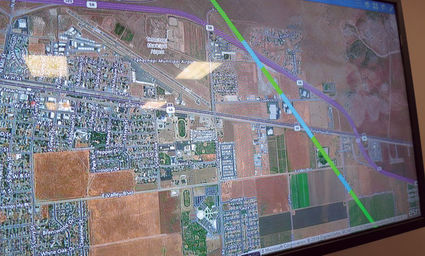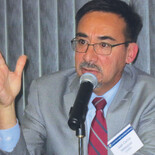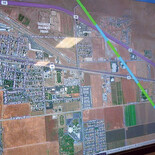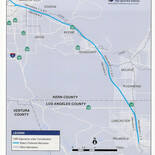Hi-Speed Rail: Slow process for fast train
The Forde Files No. 175
September 15, 2018

Tina Fisher Cunningham
High-Speed Rail proposed alignment (black and white diagonal) as it passes over Hwy. 58 and Tehachapi Boulevard in Tehachapi. The black is grade level and the white is elevated. The line passes west of Antelope Acres and over an airplane parts manufacturing plant.
Public hearings for draft environmental report due summer 2019
Piece by piece, elements of the massive California High-Speed Rail (HSR) project are falling into place as planners move ahead like the tenacious tortoise who prevailed over the overconfident and dismissive hare.
In this case, the hare is the portion of the population of California whose favorite word for the project is "boondoggle."
The tortoise keeps moving steadily ahead.
"There are 120 miles [of track] under construction and 21 active construction sites in the Madera-Fresno area," Bakersfield-to-Palmdale Section Project Manager Juan Carlos Velasquez said at a Sept. 5 HSR public update meeting at the Tehachapi Area Association of Realtors community room.
A popular interactive display enabled the approximately 40 people at the meeting to enter their addresses to determine exactly how close their property is to the proposed rail line.
A plentiful cohort of engineers, planners, environmental experts and public relations personnel were on hand to answer questions, many of whom have been working on the project since its inception and have been to Tehachapi for previous HSR public presentations. One woman told Forde Files that when she started with HSR, her child was three years old. The child is now in high school.
Public hearings on the Draft Environmental Impact Report (DEIR) for the Bakersfield-to-Palmdale section of the HSR will be held during the summer of 2019. Bakersfield-to-Palmdale Environmental Manager Kevita Mehta said the final EIR could be approved by the end of 2019. EIR approval is the trigger for actual construction.
The full first phase of the High-Speed Rail from San Francisco to Los Angeles is scheduled to be completed by 2033.
The 80-mile Bakersfield-to-Palmdale segment will feature stations in those two cities but none in between. [See box with list of stations]. An abundance of stations, where the speeding passenger train slows down, loads, unloads and gets up to speed again, would defeat the purpose of the high-speed rail, which, as proposed, cannot puddle-jump like regional airlines.
"The [Authority] statute mandates speed and limits the number of stations," Velasquez said. "We don't want to stop a lot."
Tehachapi may get a station one day.
"We have a long straight flat piece of track worked out with the city of Tehachapi," he said. "In the future, if other leaders of the state want a station here it could be placed here."
That straight stretch of track is at the east end of the Tehachapi Valley, crossing Tehachapi-Willow Springs Road, City Manager Greg Garrett told Forde Files.
"We have to have a one-mile straight stretch to consider a station. We cannot re-align ten years after it's built."
While high-speed rail is designed and built to connect one large city to another, Garrett said, with good planning looking "20, 30 years out," Tehachapi can avoid the fate of struggling cities that were cut off when the freeways by-passed them.
"As the economy grows, we don't want to be left out," Garrett said. "Maybe we will need it [a station] or not. We will have that ability."
A local station would enable residents to commute to other cities and would provide access for major companies in the area, including the international minerals giant Rio Tinto and the numerous high-tech space hothouses at the Mojave Air and Space Port.
HSR Regional Engineer Rick Simon assured a questioner that the elevated rail line with its electrical superstructure would not affect operations at Mountain Valley Airport.
"We are low enough in that area that it won't affect the flight zone," he said.
Members of the engineering and environmental team said that contractors utilize mitigation measures to combat Valley Fever at the construction sites and as they learn more about the fungal spores, incorporating the information in the environmental documents.
Velazquez said that the trains will reach 220 miles an hour. Six to eight trains will run at full build-out and maturity of the system.
That's a way off, however.
"I don't think any of us in our lifetime will see that happen."
Most of the trains will run during peak commuting hours and none will run overnight.
Maintenance will be done at night.
HSR will sell the concession to an operator, who will maintain the equipment, arrange the schedule and sell tickets.
While the noise impact of a passing train has been "thoroughly analyzed," the engineers said, it is unknown what the specific sound will be in any given spot, as there are various corridors, hills, freeways and canyons that would affect the sound of a passing train.
There is noise associated with a high-speed train, Velasquez said, but it goes by so fast that the disturbance is momentary
Phase I of the project has helped expedite light rail and other transportation improvements on both ends of the 500-mile Phase I from San Francisco to Los Angeles. The high-speed rail line eventually will be built out for 800 miles to include Sacramento and San Diego.
The 80-mile Bakersfield-to-Palmdale section over Tehachapi Summit is the most challenging segment of the project.
"It is one of the most complex systems," Velasquez said.
The rural alignment includes mountains, ranches, wind turbines, the Park Service, solar farms and mining.
"We have to thread the needles through all those different things," he said.
Studies and public input will determine the exact alignment in several sections of the Bakersfield-to-Palmdale track.
"Keene, Edison, Rosamond and Lancaster are where there are alternatives," Velasquez said.
At Edison, where the rail line will interface with Hwy. 58 at the bottom of the western slope of the Tehachapi grade, an alternative alignment would place the track farther from the 58. At the Cesar Chavez National Monument up the hill at Keene, the concern is visual.
"We have been working with the agencies that are charged with protecting that site," Velasquez said.
He said the HSR Authority is working closely with the city of Tehachapi to address alignment in relation to future development on the north side and recreation areas there. That portion of the city, which is north and east of the new hospital, is a blank spot on maps and completely undeveloped.
On the south slope of the Tehachapi Mountains, the alignment skirts mining areas where blasting is carried out as well as wind turbines and solar farms.
In Lancaster, planners are working out how to interface with Sierra Highway.
The Bakersfield-to-Palmdale EIR may be coming up in a year, but on the official HSR Authority map for phased implementation, the portion from Bakersfield all the way to Burbank is a lonely string of blue that is marked neither Phase 1 nor Phase 2. The planners put to rest an earlier proposed route over the mountains that would have followed I-5 over the Grapevine, as it would have involved too much tunneling, so the Tehachapi summit route is a certainty.
The tough Chinese crews of the Southern Pacific Railroad built the first rail line and tunnels over the Tehachapi summit in 1876 in about two years. The High-Speed Rail is taking a bit longer, but the tortoise is moving inexorably forward.








